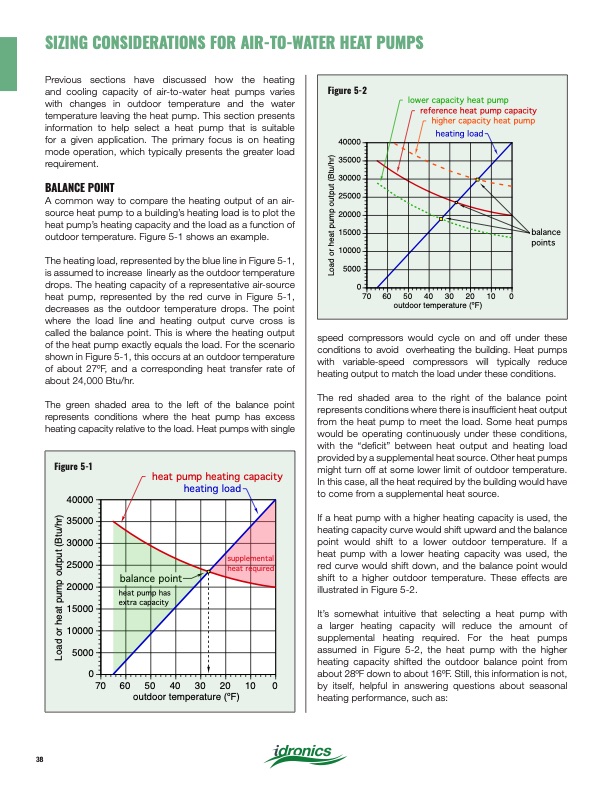
PDF Publication Title:
Text from PDF Page: 038
Figure 5-2 40000 35000 30000 25000 20000 lower capacity heat pump reference heat pump capacity higher capacity heat pump heating load 15000 balance 10000 5000 070 60 50 40 30 20 10 0 outdoor temperature (oF) points Figure 5-1 40000 35000 30000 25000 20000 15000 10000 5000 070 60 50 40 30 20 10 0 outdoor temperature (oF) heat pump heating capacity heating load supplemental heat required b alance point heat pump has extra capacity SIZING CONSIDERATIONS FOR AIR-TO-WATER HEAT PUMPS Previous sections have discussed how the heating and cooling capacity of air-to-water heat pumps varies with changes in outdoor temperature and the water temperature leaving the heat pump. This section presents information to help select a heat pump that is suitable for a given application. The primary focus is on heating mode operation, which typically presents the greater load requirement. BALANCE POINT A common way to compare the heating output of an air- source heat pump to a building’s heating load is to plot the heat pump’s heating capacity and the load as a function of outdoor temperature. Figure 5-1 shows an example. The heating load, represented by the blue line in Figure 5-1, is assumed to increase linearly as the outdoor temperature drops. The heating capacity of a representative air-source heat pump, represented by the red curve in Figure 5-1, decreases as the outdoor temperature drops. The point where the load line and heating output curve cross is called the balance point. This is where the heating output of the heat pump exactly equals the load. For the scenario shown in Figure 5-1, this occurs at an outdoor temperature of about 27oF, and a corresponding heat transfer rate of about 24,000 Btu/hr. The green shaded area to the left of the balance point represents conditions where the heat pump has excess heating capacity relative to the load. Heat pumps with single speed compressors would cycle on and off under these conditions to avoid overheating the building. Heat pumps with variable-speed compressors will typically reduce heating output to match the load under these conditions. The red shaded area to the right of the balance point represents conditions where there is insufficient heat output from the heat pump to meet the load. Some heat pumps would be operating continuously under these conditions, with the “deficit” between heat output and heating load provided by a supplemental heat source. Other heat pumps might turn off at some lower limit of outdoor temperature. In this case, all the heat required by the building would have to come from a supplemental heat source. If a heat pump with a higher heating capacity is used, the heating capacity curve would shift upward and the balance point would shift to a lower outdoor temperature. If a heat pump with a lower heating capacity was used, the red curve would shift down, and the balance point would shift to a higher outdoor temperature. These effects are illustrated in Figure 5-2. It’s somewhat intuitive that selecting a heat pump with a larger heating capacity will reduce the amount of supplemental heating required. For the heat pumps assumed in Figure 5-2, the heat pump with the higher heating capacity shifted the outdoor balance point from about 28oF down to about 16oF. Still, this information is not, by itself, helpful in answering questions about seasonal heating performance, such as: 38 Load or heat pump output (Btu/hr) Load or heat pump output (Btu/hr)PDF Image | Heat Pump Systems 2020

PDF Search Title:
Heat Pump Systems 2020Original File Name Searched:
idronics_27_na.pdfDIY PDF Search: Google It | Yahoo | Bing
CO2 Organic Rankine Cycle Experimenter Platform The supercritical CO2 phase change system is both a heat pump and organic rankine cycle which can be used for those purposes and as a supercritical extractor for advanced subcritical and supercritical extraction technology. Uses include producing nanoparticles, precious metal CO2 extraction, lithium battery recycling, and other applications... More Info
Heat Pumps CO2 ORC Heat Pump System Platform More Info
| CONTACT TEL: 608-238-6001 Email: greg@infinityturbine.com | RSS | AMP |